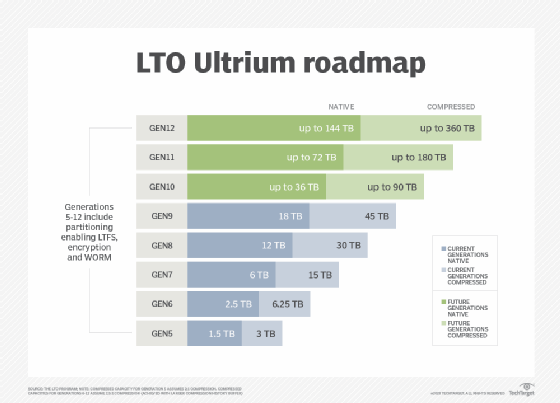Future of tape backup built on consistent advancements (original) (raw)
Article 1 of 4
Part of: Tape backup today
Tape still plays a key role in backup, including offline protection from ransomware. What are some key improvements that will keep tape backup relevant in the future?
About a decade ago, magnetic tape storage for backup started falling out of fashion. Disk-based backups became all the rage because of their ability to provide continuous data protection and, eventually, instant recovery for virtual machines.
Even so, tape never completely went away, and in recent years, there has been a renewed interest in the medium. This is largely because magnetic tape storage can store data offline, where it is protected from ransomware. Even so, incorporating tape into your data protection strategy does not necessarily mean having to go back to using outdated technology. The future of tape backup appears to contain even more growth.
Tape has continued to evolve and remains a viable option, even in today's world. Here are a few major improvements in recent years.
Capacity continues to grow
The most obvious advancement in magnetic tape storage technology is capacity increases. LTO-8 (Linear Tape-Open), which was introduced at the end of 2017, has a raw data capacity of 12 TB per tape. Specifications already exist for LTO-9 through LTO-12, which will further increase uncompressed future tape backup capacities all the way up to 144 TB.

The ultimate ransomware protection?
Tape is a good choice to ensure the security and integrity of data backups. Tapes stored offline create a physical air gap, which renders ransomware attacks unable to reach those backups. However, that does not make them invincible.
Although it is impossible for ransomware to attack a tape that is not currently mounted, there are other ways for a ransomware infection to occur. Conventional wisdom has long held that the best option for ransomware recovery is to restore a backup, but this recommendation comes with a major caveat. An organization that has been attacked by ransomware must take steps to neutralize the ransomware prior to restoring a backup. Otherwise, when the organization mounts the backup tape, it too could potentially become infected, rendering the backup useless.
Tapes stored offline create a physical air gap, which renders ransomware attacks unable to reach those backups.
Despite this potential for risk, tape-based backups offer some security advantages over disk-based backup systems.
LTO tapes, beginning with LTO-3, make it possible to treat tapes as write-once, read-many (WORM) media. This means that even if a well-intentioned backup operator were to mount a backup tape in an infected system, the ransomware cannot encrypt or delete the tape's contents, since the tape is acting as read-only media.
Other security benefits
The ability to use an LTO tape as WORM media can have other advantages beyond ransomware protection. Some organizations may find that the ability to create read-only backups makes it easier to comply with regulatory mandates. Similarly, read-only media can help to better protect an organization against accidental data loss, which is the entire point of having a backup.
LTO tapes offer other security advantages beyond their ability to act as WORM media. Regulatory standards commonly require organizations to encrypt their backups, and tape encryption has been supported since the release of the LTO-4 standard. Even if an organization is not subject to regulatory mandates, it may still benefit from the ability to create encrypted backups. By encrypting a backup tape, an organization protects itself against data being stolen and leaked if, for example, a rogue employee decides to steal a backup tape.
Partitioning
Another advancement in magnetic tape storage is the use of partitioning, which was first introduced in the LTO-5 standard. The idea was that a tape could be divided into two partitions: one to store the tape's index and the other to store the actual data. Partitions made it possible for a backup application to go directly to the spot on the tape that contained the necessary data rather than searching the entire tape. This approach dramatically improved performance. Early on, an organization that needed to restore a single file from tape backup might have to spend hours waiting for a tape to be indexed before the actual restoration could even begin.
Partitioning was further improved with the introduction of LTO-6. LTO-6 and all subsequent LTO generations have supported four partitions instead of just two. This enables a tape to behave similarly to a disk thanks to the Linear Tape File System. Administrators can drag and drop data from the file system to a tape as effortlessly as if they were copying the data to a disk.
While it is true that backup operators tend not to drag and drop files to tape as a part of normal backup operations, there are use cases in which such operations can be extremely beneficial. If, for example, an organization needs to back up a single large file, then it may be faster to write the file to tape than to write it to disk. LTO tapes generally have slower seek times than disks do, but they have very fast streaming data transfer rates, which makes them ideal for backing up large files.
Dig Deeper on Archiving and tape backup
-
 Storage technology explained: Key questions about tape storage By: Stephen Pritchard
Storage technology explained: Key questions about tape storage By: Stephen Pritchard -
 LTO-8 (Linear Tape-Open 8)
LTO-8 (Linear Tape-Open 8)  By: Stephen Bigelow
By: Stephen Bigelow -
 LTO-9 (Linear Tape-Open 9)
LTO-9 (Linear Tape-Open 9)  By: Paul Crocetti
By: Paul Crocetti -
 LTO-7 (Linear Tape-Open 7)
LTO-7 (Linear Tape-Open 7)  By: Paul Crocetti
By: Paul Crocetti
Related Q&A from Brien Posey
How can flape storage help my organization?
While flape was a concept coined by Wikibon back in 2012, now might be the time to employ the combination of flash and tape for a multi-tier storage ...Continue Reading
How to set up a Windows Server 2022 domain controller
While the process to migrate from a legacy domain controller is not difficult, it does require advanced preparation to avoid connectivity issues and ...Continue Reading
Microsoft Hyper-V vs. VMware vSphere: Feature comparison
Hyper-V and VMware are in a perpetual battle for supremacy in the virtualization market. Although the hypervisors have similar features, they differ ...Continue Reading
Part of: Tape backup today
Article 1 of 4